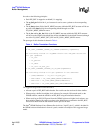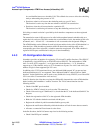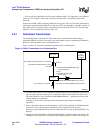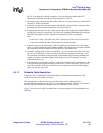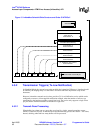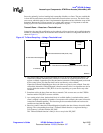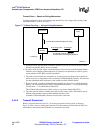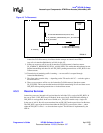
Intel
®
IXP400 Software
Access-Layer Components: ATM Driver Access (IxAtmdAcc) API
April 2005 IXP400 Software Version 2.0 Programmer’s Guide
56 Document Number: 252539, Revision: 007
its own identifier known as a scheduler VcId. This callback also serves to allow the scheduling
entity to acknowledge the presence of VC.
• Function to submit a cell count to the scheduling entity on a per-VC basis.
This function is used every time the user submits a new PDU for transmission.
• Function to clear the cell count related to a particular VC.
This function is used during a disconnect to stop the scheduling services for a VC.
No locking or mutual exclusion is provided by the IxAtmdAcc component over these registered
functions.
The transmission-control API expects to be called with an updated transmit schedule table on a
regular basis for each port. This table contains the overall number of cells, the number of idle cells
to transmit, and — for each VC — the number of cells to transmit to the designated ATM port.
The ATM Scheduler can be different for each logical port and the choice of the ATM scheduler is a
client decision. ATM scheduler registrations should be done before enabling traffic on the
corresponding port. Once registered, a scheduler cannot be unregistered. If no ATM scheduler is
registered for one port, transmission for this port is done immediately.
4.4.3 VC-Configuration Services
IxAtmdAcc provides an interface for registering VCs in both Tx and Rx directions. The ATM VC
is identified by a logical PHY port, an ATM VPI, and an ATM VCI. The total number of ATM
AAL-5 or AAL-0 VCs supported — on all ports and in both directions — is 32. IxAtmdAcc
supports up to 32 Rx channels, and up to 32 Tx channels on all ports. For AAL-5 and AAL-0, the
number of logical clients supported per-VC is one.
In addition to the 32 VCs mentioned above, one dedicated OAM transmit VC per port and one
dedicated OAM receive VC are supported. These dedicated OAM VCs behave like an “OAM
interface” for the OAM client, and are used to carry OAM cells for any VPI/VCI (even if that VPI/
VCI is one of the 32 connected for AAL services).
In the Tx direction, the client has to register the ATM traffic characteristics to the ATM scheduler
before invoking the IxAtmDAcc “connect” function. The TxVcConnect function does the
following actions:
• Checks if the PHY port is enabled.
• Checks for ATM VC already in use in an other TX connection.
• Checks if the service type is OAM and, if so, checks that the VC is the dedicated OAM-VC for
that port.
• Checks the registration of this VC to the registered ATM scheduler.
• Binds the VC with the scheduler associated with this port.
• Registers the callback by which transmitted buffers get recycled.
• Registers the notification callback by which the hardware will ask for more data to transmit.
• Allocates a connection ID and return it to the client.
In the Rx directions, the RxVcConnect steps involve the following actions:
• Check if the PHY port is enabled.



